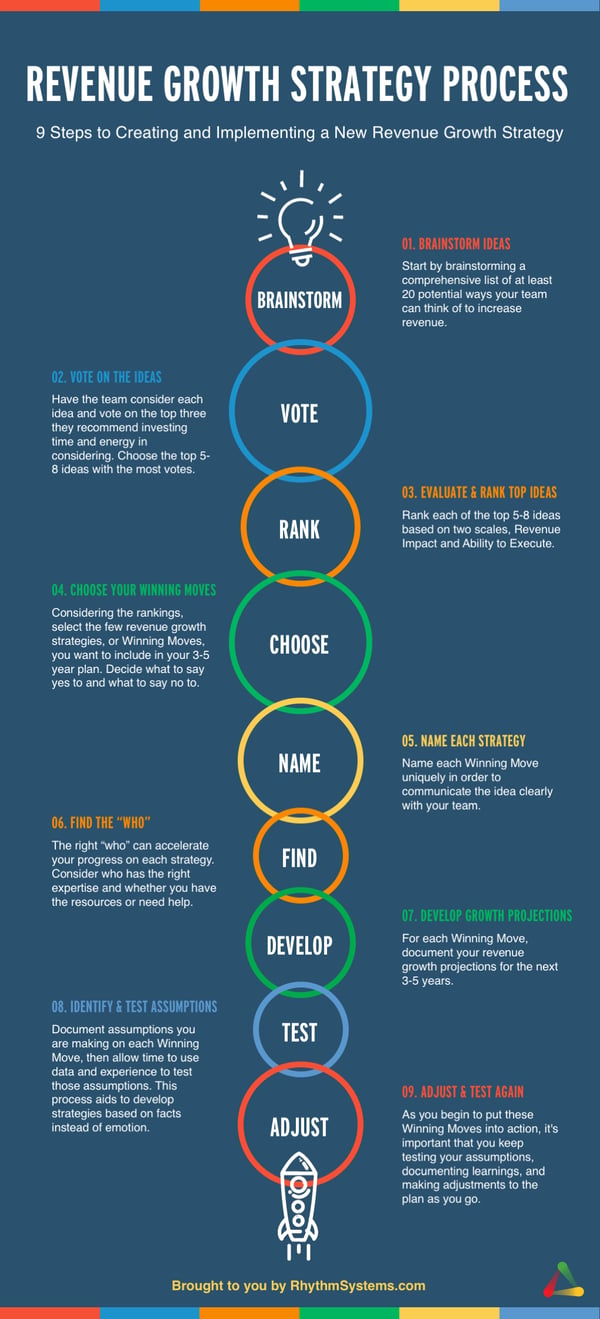Working with middle market CEOs, we are often asked "What is revenue growth strategy?" Driving revenue is the number 1 concern for most CEOs. Many leaders romanticize about striking it big overnight with a brilliant business idea. We've all seen that  moment in movies where inspiration strikes in the middle of the night, and some innovative new product or idea launches a company to greatness. In reality, you can't wait around for lightning to strike to keep your company growing. As Patrick Thean shares in his book Rhythm, growth strategies "do not come from eureka moments. They are developed over time..."
moment in movies where inspiration strikes in the middle of the night, and some innovative new product or idea launches a company to greatness. In reality, you can't wait around for lightning to strike to keep your company growing. As Patrick Thean shares in his book Rhythm, growth strategies "do not come from eureka moments. They are developed over time..."
Even if you're not trying to be the next Apple, companies in today's competitive landscape have to be disciplined about anticipating what's next and how to generate revenue in the future. If you aren't thinking about your next 3 year strategic plan with growth ideas and actively working on it in your Annual Planning sessions, you're already behind. If you want a continuous supply of revenue-generating strategies, you need to spend time thinking strategically, and you need a process for creating and implementing your strategies to grow revenue.
Revenue Growth Strategy Step 1: Brainstorm Ideas
Start by brainstorming a comprehensive list of at least 20 potential ways your team can think of to increase revenue. Remember at this stage you are just brainstorming, so don't worry if any ideas seem too wild or out there - they might end up leading to the perfect idea in a later stage. What products and services could open up new markets? What is your revenue growth plan?
Revenue Growth Strategy Step 2: Vote
Have the team consider each of the ideas and have them vote on their favorites. Try to get it down to 5-8 ideas that you think consider further exploration and discussion. Think about how the idea affects all of the different departments in your business. Does this strategy work with our existing customers, or are we going to need to get a new customer base?
Revenue Growth Strategy Step 3: Rank
After discussing the ideas in more detail in step 2, take the time to rank each of the top 5-8 ideas based on two scales. The first is a ranking from 1-10 on the impact on revenue, with a ten being the highest. Then rank the same initiatives on the ability to execute them, with a 10 being the easiest to implement as you already have most of the expertise and resources needed to execute on it.
Revenue Growth Strategy Step 4: Choose
Now that you have ranked them, it is time to choose the top "Winning Move" or revenue growth strategy based on the ranking that would be easiest to implement with the highest revenue growth potential. Include this in your 3-5 year business plan that will help you decide what to say "yes" to and what to say "no" to, allowing you to maintain your focus.
Revenue Growth Strategy Step 5: Name
Name each revenue growth strategy, or Winning Move, in order to quickly and easily communicate with your team. Giving the project a name also allows the team to rally around the project. It's okay to name it something fun, or something that matches your company culture. This isn't necessarily the name that marketing and sales will use the product or service goes to market.
Revenue Growth Strategy Step 6: Find the "Who"
The right "who" can really accelerate your growth strategy. Consider who has the right expertise to help you execute this strategy? Do you have the talent in house? Do you need hir hire someone outside of the organization? Is there a member currently in your organization that can grow into the new role? Who will purchase this? What does your target customer look like? What buyer persona will drive the marketing strategy?
Revenue Growth Strategy Step 7: Develop Projections
Develop a 3 year business plan with revenue growth projections for each of your Winning Moves. This will help you test the assumptions that are built into your business model so that you can make any needed adjustments and maintain an agile organization. Will any new sales processes need to be set up?
Revenue Growth Strategy Step 8: Test Assumptions
Document all of the assumptions in your revenue growth strategy, every one that you can think of. Then allow time and data to validate or disprove those assumptions. This allows your business to make decisions based on data and facts, not emotions. Too many times we have seen too much energy put into a Losing Move, because people were emotionally attached to an idea and ignored the facts.
Revenue Growth Strategy Step 9: Adjust and Test
As you begin to put these strategies into action it is important that you continually test and document your assumptions. Document your learnings and make adjustments to the business plan as you go. You need to continuously improve your strategies and tactics to help you reach your goals. Has this increased sales? Does it meet your revenue plan?
Here's our proven process for creating and executing on your 3-5 year revenue growth strategies

Interested in learning more about your 3 year strategic plan?
The CEOs Strategy-Execution Gap...And How To Fix It
Choose Your 3 Year Strategic Growth Initiatives Wisely With This 4 Step Process
5 Steps to Getting Started on 3 Year Strategic Plans with Winning Moves
Have You Validated Your 3 Year Strategic Plan?
Strong 3 Year Strategic Plans to Grow Revenue and Stay Competitive
16 Strategic Planning Tips to Keep Your Strategic Plan Alive
Don't Confuse Strategic Thinking And Strategy Execution Plans
9 Steps to a New Revenue Growth Strategy [Infographic]
Photo Credit: iStock by Getty Images



